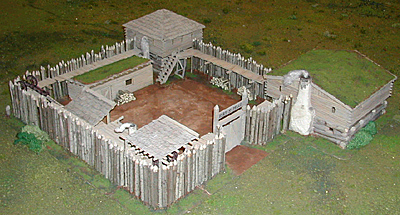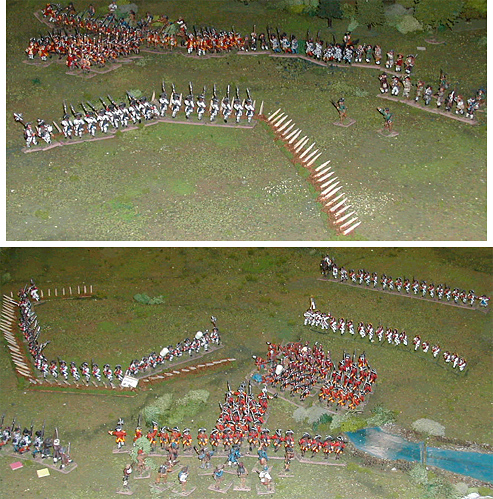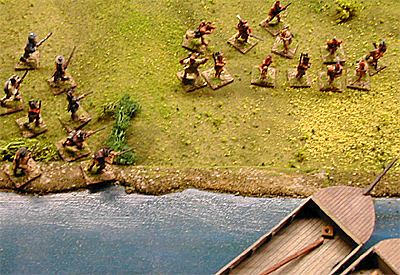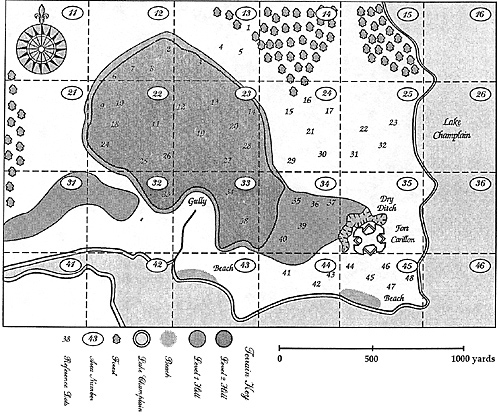 The French awoke to another misty morning on the banks of Lake Champlain in the hinterlands of New France, or what would be New France once the outrageous British incursions had been curbed. And my have they encroached again upon New France. Indian allies brought word of a British force on the march with colonist militia. The target could only be Fort St. Mills, nee Carillon.
The French awoke to another misty morning on the banks of Lake Champlain in the hinterlands of New France, or what would be New France once the outrageous British incursions had been curbed. And my have they encroached again upon New France. Indian allies brought word of a British force on the march with colonist militia. The target could only be Fort St. Mills, nee Carillon.
Dawn arrives at Fort St. Mills. This hand-built model by Mike Hansen measures two-feet square and uses native building materials found outside on his lawn.
Fort St. Mills was as awkwardly a placed wooden palisade fort as one could site--at least from the landward side. Hills to the northwest dominated the fort. If artillery could be lodged atop them, the fort could be battered into splinters. Some measures were taken--a redoubt was built at that very spot, with at least some token obstructions to prevent a walkover. Yet it did dominate the lake and river, and its cannons without would rain iron pain upon those who tried to force their way past.
 The garrison was adequate, but not overly strong. Three line battalions, one elite grenadier battalion, one small elite marine contingent, and one small militia group of backwoodsmen, trappers, and other rogues made up the trustworthy force. Then, there were three warparties of Indians, for whatever worth those would be in a battle. That they had brought advance word of the attack was all that could be reasonably expected of them. Too bad they did not say exactly how many British were on the march.
The garrison was adequate, but not overly strong. Three line battalions, one elite grenadier battalion, one small elite marine contingent, and one small militia group of backwoodsmen, trappers, and other rogues made up the trustworthy force. Then, there were three warparties of Indians, for whatever worth those would be in a battle. That they had brought advance word of the attack was all that could be reasonably expected of them. Too bad they did not say exactly how many British were on the march.
 The Plans
The Plans
Jumbo Photo of Table Setup: slow: 136K)
Two Indian warparties hid in the woods to the north, while the third guarded the beach up river. Two French line battalions manned the redoubt, with the small reserve of marines inside to stiffen them up. The other line battalion and the grenadier battalion would remain out of site on the side of the hill, waiting to see which way the British would advance. The militia was left inside the fort, about the only place where rogues would stay put.
The British advanced along the river, with American units arrayed northward towards the interior, and Rogers Rangers sweeping far north and around the hill. The idea would be to screen the front of the redoubt, while the main column advanced eastward between the gully and the redoubt. A group of militia would be the diversion as they floated downriver in bateaus to ground on a beach.
 The Battle
The Battle
The envelopment of the redoubt began as promised, although the American battalions stumbled out of the woods from the west in a ragtag formation--if formation it could be called. They rallied and began the task of screening the redoubt. Rogers Rangers swept around in grand style. All of them started to pepper the redoubt with musketry and rifle fire. The British columns marched along the river in far better order and began to edge inland to skirt the gully. Meanwhile, the militia floated downriver.
Top: The defenders of the redoubt look down at the approaching British troops in front and American troops on the right. Rogers Rangers curl off photo to the right.
Bottom: The French maintain the redoubt while reserves hurry to plug the gap. The Indians launch an attack from the redoubt on the British, but flee. The British get caught in a crossfire and are repulsed.
The white caps designate casualties. The square counters reflect disorder and temporary out of ammunition.
Desultory fire from the redoubt did nothing to hinder the advance. The French reserve stepped out smartly and plugged the gap between gully and redoubt. Cannonfire from the fort churned the water around the boats and disordered the water-based attack. Paddles were dropped and the American militia tried to crouch low in the boats to avoid the cannonballs. Indians lined the bank and shot into the confusion.
Meanwhile, the multiple British battalions charged the French line and grenadiers, only to be beaten back. Reforming, the British charged again, and again were met with a hail of musket fire and sent reeling. And they went in again, and were repulsed again for the third time. This time, the Indians, who had crept up behind the redoubt, came screaming over the hill into a British battalion.
Yet the British held firm and sent the Indians fleeing with displays of close-order bayonet drill. The French gave a little ground and the British sent their columns crashing into the French once more. And once more were forced back, refusing to close.
Meanwhile, the French inside the redoubt were taking casualties from the massed American fire. Two bands of Indians emerged from the woods and charged Rogers Rangers, but found them resolute in the face of melee. The Indians fled back into the woods.
It was at this time that the nerve of the French commander in the redoubt started to crack. The pair of line troops were steady, but their leader's resolve proved fragile. He declared that they had no more ammunition and must pull back from the devastating firefight. But no, the commander of the French marines would have none of that talk, and screamed for the men to get back into the line and threatening them with bayonets if they tried to retreat. "Hold them with la bayonet!" he shouted, whacking men back into place with the flat of his sword. "No retreat! Back into the line!" The magic of nerve worked, and a good thing, too, for the British had regrouped and were setting up a charge for a fifth time.
 Death's a Beach
Death's a Beach
Meanwhile, back at the river, the boats grounded from the current. Indian musket fire, coupled with more devastating cannon fire from the fort, kept the American militia in the boats. The Indians scented blood and plunder. They swarmed into the boats. Little was clear from the melee except that in the end, the Indians were forced from the boats and back away from the beach.
Scratch-built boats from Mike Hansen disgorge American militia, who were repulsed in hand-to-hand melee with the Indians and fled away from the Indians and boats.
This gave heart to the befuddled masses of militia. In ones and twos, and then en masse, they stormed off the boats and into the Indians--right about the time the fifth charge at the main line of the gully was being fought, which was at the same time the Redoubt commander was losing his nerve. It was make or break time for the French.
The sun smiled on the French. The redoubt commander regained his nerve. The Indians repulsed the American militia beach invasion, and the fifth British charge fared no better than the first four. Even the rogues in the fort, once they saw the Indians stand firm, streamed out of the fort to join the fray. The British made one more half-hearted attempt to pierce the French line, but that ended badly as well. The American militia didn't even bother getting back in the boats--they fled for the gully and home.
Aftermath
The Indians chased the militia, but not very far--boat plunder was at hand, and they had earned it. The French in the redoubt took the worst of it but held, for they were the key to the defense. The French line and grenadiers fought superbly, repulsing six successive attacks. Sadly, the overall commander fell towards the end, which dimmed the heroic defense of the fort. The other Indians did about as expected. They still held the woods and served as a deterrent for any force trying to bypass the redoubt from the north and east.
As for the British, their attacks failed miserably, although only by the smallest of margins. Of dead and wounded, they left many behind, but it was not a routed force that left the battlefield. The Americans suffered hardly any loss at all in taking potshots at the troops in the redoubt. And as for the American militia, well, they told tales of savage hand-to-hand fighting for the boats and of an endless supply of Indians, but they were alive to tell the tales.

Commentary
(This battle report came about because MagWeb.com purchased a Nikon 775 Coolpix digital camera, which arrived the day of the tabletop battle. With nothing but a cursory reading of the "Read This First" instructions, I went in with shutters blazing. It was a week later that I actually installed the software to retrieve the images from the camera--and found out that 90% of what I shot was completely unusable. Although it all looked good on a 1.5-inch LCD screen, a look on a 19-inch monitor revealed lots of blurry photos.
One of the tricks of camera work (the 775 is about the size and weight of a mouse) is to hold the thing steady. I've taken thousands of photos, in good light and bad, peeking through the viewfinder of a 35mm camera. However, with the 775, you look at the CCD screen on its back. As a result, my first efforts were mostly a blur, especially with the low light conditions of the basement. In others, I took wonderful, in focus shots of the background and everything in the foreground was fuzzy. Ah, the learning curve. Some photos did come out--at least enough to use and illustrate the wargame. I hope to do better next time. I also have to see about getting a tripod...
The battle was fought at Fort St. Mills (well, his basement, anyway) using modified Fire and Fury rules, and run by Marc Raiff and Dave Mills. --RL).
Back to War Lore: The List
Back to Master Magazine List
© Copyright 2002 by Russ Lockwood.
This article appears in MagWeb (Magazine Web) on the Internet World Wide Web.
Other military history articles and gaming articles are available at http://www.magweb.com